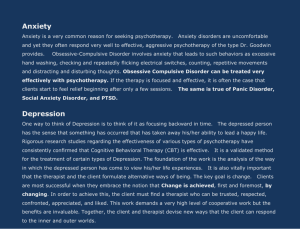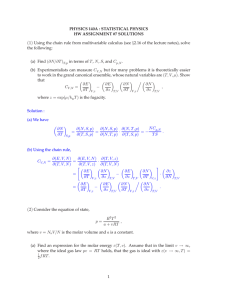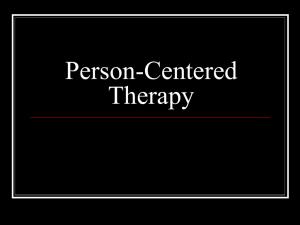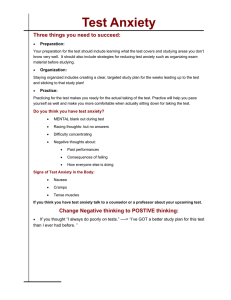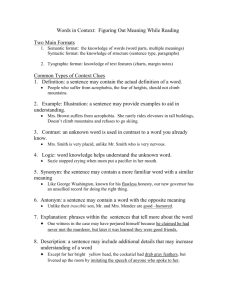State of the art of virtual reality therapy (VRT) in... Stéphane Roy
advertisement
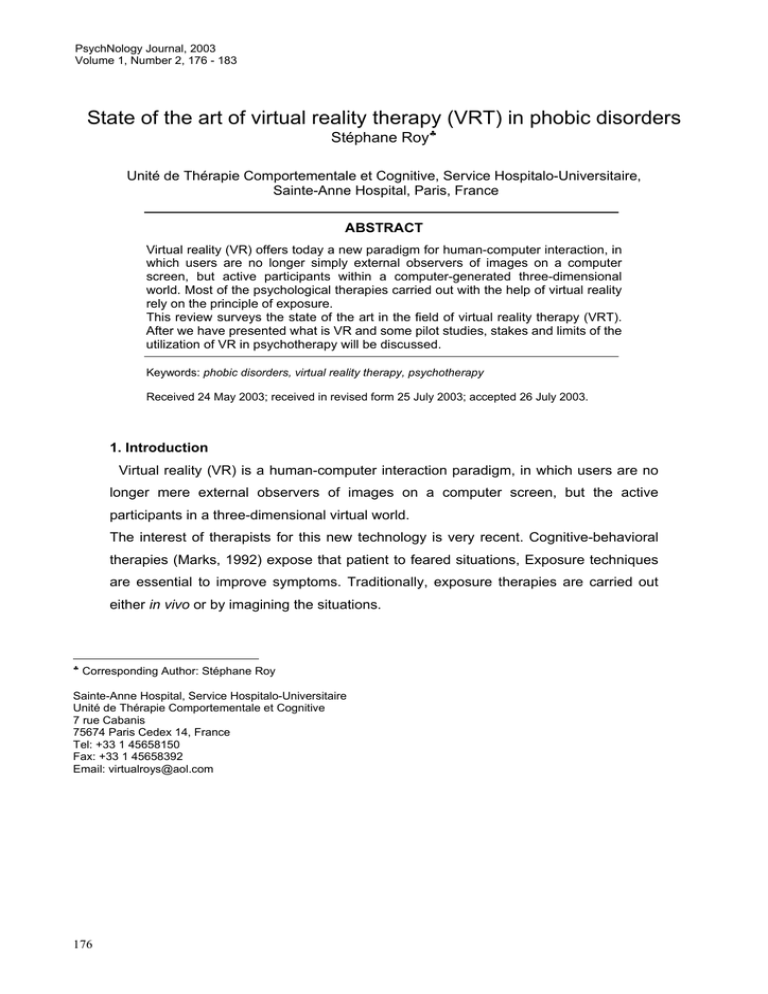
PsychNology Journal, 2003 Volume 1, Number 2, 176 - 183 State of the art of virtual reality therapy (VRT) in phobic disorders Stéphane Roy♣ Unité de Thérapie Comportementale et Cognitive, Service Hospitalo-Universitaire, Sainte-Anne Hospital, Paris, France ABSTRACT Virtual reality (VR) offers today a new paradigm for human-computer interaction, in which users are no longer simply external observers of images on a computer screen, but active participants within a computer-generated three-dimensional world. Most of the psychological therapies carried out with the help of virtual reality rely on the principle of exposure. This review surveys the state of the art in the field of virtual reality therapy (VRT). After we have presented what is VR and some pilot studies, stakes and limits of the utilization of VR in psychotherapy will be discussed. Keywords: phobic disorders, virtual reality therapy, psychotherapy Received 24 May 2003; received in revised form 25 July 2003; accepted 26 July 2003. 1. Introduction Virtual reality (VR) is a human-computer interaction paradigm, in which users are no longer mere external observers of images on a computer screen, but the active participants in a three-dimensional virtual world. The interest of therapists for this new technology is very recent. Cognitive-behavioral therapies (Marks, 1992) expose that patient to feared situations, Exposure techniques are essential to improve symptoms. Traditionally, exposure therapies are carried out either in vivo or by imagining the situations. ♣ Corresponding Author: Stéphane Roy Sainte-Anne Hospital, Service Hospitalo-Universitaire Unité de Thérapie Comportementale et Cognitive 7 rue Cabanis 75674 Paris Cedex 14, France Tel: +33 1 45658150 Fax: +33 1 45658392 Email: virtualroys@aol.com 176 Virtual Reality Therapy In vivo exposure is sometimes difficult to control. VR techniques enable to recreate three-dimensional worlds and reproduce realistic situations where a user can move and interact with artefacts. VR has the advantage of allowing exposures to numerous and varied situations. In this review, we give a definition of VR and present some first studies using VR therapy. We then assess the stakes and limits of the utilization of virtual reality in psychotherapy. 2. What is Virtual Reality? Sutherland (1965) is considered as the father of VR technology. VR can be defined as the simulation of a real or imagined environment that can be experienced visually in the three dimensions of width, height, and depth and that may additionally provide an interactive experience visually in full real-time motion with sound and possibly with tactile and other forms of feedback. The simplest form of VR is a 3-D image that can be explored interactively with a personal computer, usually by manipulating keys or the mouse so that the content of the image moves in some direction or zooms in or out. As the images become larger and interactive controls more complex, the perception of “reality” increases. More sophisticated systems involve approaches such as wrap-around display screens, augmented reality that projects images in a real environment using wearable computers, and haptics devices that let users feel a force feedback. VR can be divided into: • The simulation of real environments such as the interior of a building or a spaceship often with the purpose of training or education. • The development of an imagined environment, typically for a game or educational adventure. According to Moline (1998), virtual environments present a unified workspace allowing a more or less complete functionality without requiring all the functions being located in the same physical space. Virtual environments can be defined as interactive, virtual image displays enhanced by special processing and by non-visual display modalities, such as auditory and haptic, to convince users that they are immersed in a synthetic space (Ellis, 1994). Less technically, a virtual world is an application that lets users navigate and interact with a three-dimensional, computer-generated environment in real time. Satava (1993) has identified five elements that affect the realism of a virtual environment for medical applications: • Fidelity (high-resolution graphics), 177 S. Roy • Display of organ properties (such as deformation using morphing or the kinematics of joints), • Display of organ reactions (such as bleeding from an artery or bile from the gall bladder), • Interactivity (between objects such as surgical instruments and organs), • Sensory feedback (tactile and force feedback). In the field of VR applications in medicine, Riva (1999) and Riva & Gamberini (2000) expose three important aspects of VR systems offering new possibilities for assessment and treatment: • How they are controlled: VR systems open the input channel to the full range of human gestures. The potential is there to monitor movements or actions from any body part or many body parts at the same time. All the properties of the movement can be captured, not just the contact of a body part with an effector. In consequence, in the virtual environment, these actions or signals can be processed in a number of ways. They can be translated into other actions that have more effect on the world being controlled. • Feedback: Since VR systems display feedback in multiple modes, feedback and prompts can be translated into alternate senses for users with sensory impairments. The environment can be reduced in size to get a larger or overall perspective. For the individual, multimodal feedback ensures that the visual channel is not overloaded. VR presents information in alternate ways and in more than one way. Sensory redundancy promotes learning and integration of concepts. • Control: Virtual environments provide the opportunity to expose patients to environments that would otherwise be dangerous or inaccessible, or would generate too much initial stress for effective therapy. 3. Virtual Reality Therapy (VRT) Studies: Example of Phobias Applications of VR for mental health are recent, but several case studies demonstrated the effectiveness of exposure carried out through VR. It is principally in the treatment of phobias that VRT has been used and assessed. According to the DSM-IV (American Psychiatric Association, 1994), phobia is a marked and persistent fear that is excessive or unreasonable, cued by the presence or anticipation of a specific object or situation (e.g., flying, heights, animals, receiving an injection, seeing blood). Exposure to the phobic stimulus almost invariably provokes an immediate anxiety response, which may take the form of a situationally bound or situationally predisposed panic attack. The person recognizes that the fear is excessive or unreasonable. 178 Virtual Reality Therapy The phobic situation(s) is avoided or else is endured with intense anxiety or distress. The avoidance, anxious anticipation, or distress in the feared situation(s) interferes significantly with the person's normal routine, occupational (or academic) functioning, or social activities or relationships, or there is marked distress about having the phobia. One of the approaches to treat phobias consists in desensitizing the patient by exposure. Classically, in this mainly behavioral approach, the patient is exposed either “in vivo”, or “in imagination”. In the first case, a therapist accompanies the patient in an environment where the anxiety stimulus is met. In the second case, the patient must think of a scene confronting him/her with the stimulus. In practice, these techniques encounter a certain number of various obstacles. The approach of VR consists in immersing the patient in a synthetic universe in which the anxious stimulus is introduced in an extremely gradual and controlled way. Various types of phobias were approached within this framework. We will give two examples: Fear of flying and acrophobia. 3.1 Fear of Flying Two case studies were conducted to assess the effectiveness of VRT for the treatment of the fear of flying (North & North, 1994; North, North & Coble, 1996a, b, 1997). In the first experiment, the subject was a 32-year-old married woman, who was diagnosed and treated for fear of flying. The virtual scene was a simulated city. She participated in eight sessions, each lasting about 30 minutes. She reported a high level of anxiety at the beginning of each session, gradually reported lower anxiety levels after remaining in the situation for a few minutes and eventually reported an anxiety level of zero. To investigate the transfer effect of VRT to the real world, she was flown with the therapist accompanying her on a helicopter for approximately 10 minutes at low altitude over a beach of the Gulf of Mexico. As with the VRT sessions, she reported some anxiety at the beginning, but the anxiety rapidly reduced to a reasonably comfortable level. The second case study (North, North & Coble, 1996a, b, 1997) involved a 42-year-old married man. The subject’s anxiety and avoidance behavior were interfering with his normal activities. He was accompanied by a virtual therapist, and placed in the cockpit of a virtual helicopter and flown over a simulated city for five sessions. A modified 11point (0 for complete calm and 10 for complete panic) Subjective Units of Discomfort Scale (SUDS) scale was used to measure the degree to which the subject was affected by VRT. In VRT the subject’s anxiety usually increased as he was exposed to more challenging situations and decreased as the time in those new situations was increased. The subject experienced a number of physical and emotional anxiety- 179 S. Roy related symptoms during the VRT sessions. The VRT resulted in both a significant reduction of anxiety symptoms and the ability to face the phobic situation in the real world. 3.2 Acrophobia (Fear of Heights) Two first case studies demonstrated the effectiveness of VRT in the treatment of acrophobia. During the first one (North & North, 1996; North, North & Coble, 1996), eight sessions were conducted, which lasted between 15 and 28 minutes each. Individual VRT treatment was conducted in a standard format. The first session began with the least threatening level, which was at the ground level near a bridge crossing a river in the middle of a simulated town. The SUDS was administered periodically every two to five minutes. The progress was totally under the control of the subject, except when the subject’s SUDS score was zero, the experimenter urged the subject to move up to the next level of the scene. At one month after treatment, the subject was asked to complete a ten point rating scale (including degrees for worsening symptoms) rating the degree to which his acrophobia symptoms had changed since a pre-treatment test (SUDS). The results indicated significant improvement with respect to both anxiety symptoms and the avoidance of anxiety-producing situations. The second study (Rothbaum, Hodges, Kooper, Opdykes, Williford, & North, 1995; Rothbaum, Hodges, Opdyke, Kooper, Williford, & North, 1995) was conducted with twenty college students with acrophobia, randomly assigned to virtual reality graded exposure treatment or to a waiting-list comparison group. Sessions were conducted individually over 8 weeks. Outcomes were assessed by using measures of anxiety, avoidance, attitudes, and distress associated with exposure to heights before and after treatment. Significant improvements on all measures were found in the subjects who completed the virtual reality treatment compared to subjects on the waiting list. More recently, Botella, Banos, Perpina, Villa, Alcaniz & Rey (1998) examined the efficacy of a treatment for claustrophobia using VR exposure only. The subject was a 43-year-old female who suffered from clinically significant distress and impairment and sought psychological therapy. Eight individual VR graded exposure sessions were conducted. In this study, all self-report measures were reduced following VR exposure and were maintained at one month follow-up. In another study (Emmelkamp, Krijn, Hulsbosch, de Vries, Schuemie & van der Mast, 2002), the effectiveness of a low-budget VR exposure versus exposure in vivo in a between-group design of 33 patients suffering from acrophobia was evaluated. The virtual environments used in the treatment were the exact copy of the 180 Virtual Reality Therapy real environments used in the in vivo exposure program. VR exposure was found to be as effective as in vivo exposure on anxiety and avoidance as measured with the Acrophobia Questionnaire (AQ), the Attitude Towards Heights Questionnaire (ATHQ) and the Behavioral Avoidance Test (BAT). Results were maintained up to six months follow-up. This study showed that VR exposure can be effective with relatively inexpensive hardware and software on stand-alone computers currently on the market. A final study (Roy, Légeron, Klinger, Chemin, Lauer & Nugues, submitted) evaluated the efficacy of VR treatment for social phobia. The virtual environments used in the protocol reproduced four situations that social phobics feel the most threatening: performance, intimacy, scrutiny, and assertiveness. A first case-report was carried out. The patient is exposed to ten VR sessions. The study found that VR exposure was effective: all the self-report questionnaires showed a decrease of the symptoms following treatment and were maintained at a three-month follow-up. A future largescale clinical trial using the same protocol will be conducted to compare a VR group therapy (36 patients) versus a comparative cognitive-behavioral group therapy (18 patients) and no-treatment group (18 patients). 4. VRT: Interest and Limits VR offers several advantages compared to classical methods. One of the principal assets of VR treatment is the possibility for the therapist of control the intensity of the stimuli (e.g. the variations of the stress situations, the addition of new sources of stimuli: tactile, visual, etc.) in order to make progress in a continuous and soft way for the patient. In addition, the patient as well as the therapist has the possibility to suspend immediately a simulation in the event of faintness. It is not the case in the in vivo exposure where it is sometimes difficult to stop the exposure. Standard techniques use another type of exposure, which is the systematic desensitization. The patient has to imagine the anxious stimuli. However, some of the patients had cannot or are too phobic to imagine the situation prescribed by the therapist. VR exposure represents a flexible tool making it possible to modify and control the stimuli to which the patient is subjected in intensity and frequency. According to Vincelli (1999) VR allows adjusting very exactly the situations, to stop instantaneously the in vivo exposure, to discuss the methods, and to restart the therapy. Keeping the patient in the therapist’s office avoids her/him being exhibited and preserves the indispensable confidentiality. Although the technology is mature enough to have different applications, there are key issues to be resolved for its use for practical applications (http://www.vrhealth.com): 181 S. Roy • Costs: As with early computer graphics products, the entry-level costs are relatively prohibitive. A complete VR environment, including workstations, goggles, body suits, and software, is currently very expensive. • Lack of standard and reference parameters: The hyperbole and sensational press coverage associated with some of these technologies have led many potential users to overestimate the actual capabilities of existing systems. Many of them must actually develop the technology significantly for their specific tasks. Unless their expertise includes knowledge of the human-machine interface requirements for their application, their resulting product will rarely get beyond a “conceptual demo” that lacks practical utility. • Human factors: The premise of VE seems to be to enhance the interaction between people and their systems. It thus becomes very important to understand how people perceive and interpret events in their environments, both in and out of virtual representation of reality. We must address issues of human performance to understand how to develop and implement VE technology that people can use comfortably and effectively. Fundamental questions remain about how people interact with the systems, how they may be used to enhance and augment cognitive performance in such environments, and how they can best be employed for instruction, training, and other people oriented applications. 5. Conclusion Possibilities offered by VR in the field of the cognitive-behavioral therapies are numerous. Immersion, guide by the therapist, leads the patient to live this experiment in a more realistic way. But this “technicization” of the psychotherapy, as attractive as it is, does not modify the theoretical and methodological bases on which VRT rests. VRT has not replaced the role played by therapist. Indeed, his/her presence near to the patient remains essential. It seems that VR reinforces the therapeutic relation between patient and therapist on a collaborative mode. 6. References American Psychiatric Association (1994). Diagnostic and Statistical Manual, Fourth Edition (DSM-IV). Washington DC, APA. Botella, C., Banos, R. M., Perpina, C., Villa, H., Alcaniz, M., & Rey, A. (1998). Virtual reality treatment of claustrophobia: a case report. Behaviour Research and Therapy, 36, 239-246. Ellis, R. E. (1994). What Are Virtual Environments? IEEE Computer Graphics and Applications, 14(1), 17-22. 182 Virtual Reality Therapy Emmelkamp, P. M. G., Krijn, M., Hulsbosch, A. M., de Vries, S., Schuemie, M. J., & van der Mast, C. A. P. G. (2002). Virtual reality treatment versus exposure in vivo: a comparative evaluation in acrophobia. Marks, I. M. (1992). Behavioral psychotherapy towards the millennium. In J. Cottraux, P. Légeron, & E. Mollard (Eds.), Annual Series of European Research in Behavior Therapy. Amsterdam: Swets & Zeitlinger. Moline, J. (1998). Virtual reality for health care: a survey. In G Riva (Ed.), Virtual Reality in Neuro-Psycho-Physiology. Amsterdam, IOS Press. North, M. M., & North, S. M. (1994). Virtual environments and psychological disorders. Electronic Journal of Virtual Culture, 2(4), 37-42. North, M. M., & North, S. M. (1996). Virtual psychotherapy. Journal of Medicine and Virtual Reality, 1(2), 28-32. North, M. M., North, S. M., & Coble, J. R. (1996a). Virtual reality therapy, An innovative paradigm, CO: IPI Press. North, M. M., North, S. M., & Coble, J. R. (1996b). Application: Psychotherapy, Flight Fear Flees, CyberEdge Journal, 6(1), 8-10. North, M. M., North, S. M., & Coble, J. R. (1997). Virtual environment psychotherapy: A case study of fear of flying disorder. Presence, Teleoperators and Virtual Environments, 6(1). Riva, G. (1999). Virtual reality as a communication tool: a socio-cognitive analysis. Presence, Teleoperators, and Virtual Environments, 8, 460-466. Riva, G., & Gamberini, L. (2000). Virtual reality as telemedicine tool: technology, ergonomics and actual applications. Technology and Health Care, 8, 113-127. Rothbaum, B. O., Hodges, L. F., Kooper, R., Opdykes, D., Williford, J. S., & North, M. M. (1995). Effectiveness of computer-generated (virtual reality) graded exposure in the treatment of acrophobia. American Journal of Psychiatry, 152(4), 626-628. Rothbaum, B. O., Hodges, L. F., Opdyke, D., Kooper, R., Williford, J. S., & North, M. M. (1995). Virtual reality graded exposure in the treatment of acrophobia: A case study. Journal of Behavior Therapy, 26(3), 547-554. Roy, S., Légeron, P., Klinger, E., Chemin, I., Lauer, F., & Nugues, P. (submitted). Virtual reality therapy (VRT) of social phobia: a case report. Satava, R. M. (1993). Virtual Reality Surgical Simulator: The First Steps. Surgical Endoscopy, 7, 203-205. Sutherland, I. (1965). The ultimate display. Proceedings of the international Federation of Information Processing Congress, 2, 506-508. Vincelli, F. (1999). From imagination to virtual reality: the future of clinical psychology, CyberPsychology and Behavior, 2(3), 241-248. VRhealth web site – http://www.vrhealth.com 183
